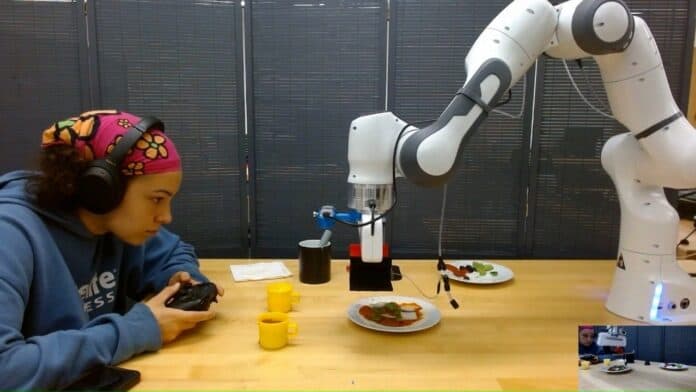For the millions of Americans who live with a mobility issue, making a pizza can be a lot more challenging than just choosing between pepperoni or sausage. Now Virginia Tech researchers have developed a robotic arm with novel assistive grippers that can help those with disabilities accomplish complex everyday tasks, including building a pizza.
The results of the research, which can increase independence for people with limited mobility, were published in Soft Robotics.
Creating new tools that can mimic the motions of human users is the work of Dylan Losey and Michael Bartlett, both associate professors of mechanical engineering. “Our philosophy is that if you are going to provide someone with a robot that can help them, it needs to have a connection to the way a person performs the same task,” said Losey. “This makes the actions of the robot more an extension of a person’s natural movements. It’s not enough just to build functional robotic systems, the systems need to be user friendly and intuitive.”
With more than $600,000 in funding from the National Science Foundation and with help from graduate student researchers like Maya Keely and Yeunhee Kim, the team created a gripper that can pick up and move objects ranging in size from a grain of sand to a heavy jug of water, and everything in between — including the ingredients for a pizza.
Dessert first
Robotics can increase independence for people with disabilities by helping them with daily tasks, but robots often struggle to keep up with the variety of tasks they’re being asked to perform, especially when it comes to making dinner. Food items are diverse, with different sizes, shapes, and textures, so the same robot capable of opening a jar of sauce, for instance, might struggle when sprinkling grated cheese. How do you teach a robot the difference between a banana and a bottle of ketchup?
In its recent work, the team programmed the robot to receive commands from a joystick similar to those used when playing a video game. Using artificial intelligence (AI), the robot began interpreting the commands to decipher what the human was trying to do, then used that data to help complete the rest of the task.
The team decided to start with something fun: using a robotic hand from Losey’s lab to build an ice cream sundae.
The first attempt did not go well.
“One of the reasons it was tough is that traditionally, robots pinch things,” Losey said. “That works great when you have something like a bottle of syrup, but when you have smaller things like sprinkles or marshmallows, it’s not as easy just to squeeze everything and hope for the best.”
Part of the problem was the material of the robotic gripper. When a gripper is made of purely soft materials, it can fumble irregular or heavy objects. When the gripper is made of more rigid materials, it often cannot grasp small items or groups of items.
Losey and Bartlett’s team decided to build a combination of the two: rigid robotics that used a soft gripper at its point of contact. Leveraging Bartlett’s work in soft materials and adhesives with unique properties, the team implemented something called switchable adhesives, which “can be strong and adhesive to pick things up, but they can also be readily turned off to release the object,” Bartlett said.
The team created a soft, bubble-like fingertip for the robotic hand that deflates a bit when it makes contact with an object, creating an adhesive bond. Adding a bit more air releases the bond. With switchable adhesives in place, the robot successfully made an ice cream sundae, sprinkles and all.
Pizza is always the best answer
Next up on the menu: pizza.
“Having the robot arm and gripper collaborate with a person to assemble a pizza really challenged every aspect of our system,” Bartlett said. “Pizzas have crust and cheese, which are different sizes. They also have sauce and toppings, which are different textures. Pizza is also a nice case study because everyone wants different toppings on their own pizza, which makes it very personal. This means the human and robot will need to coordinate so that the robot is building the pizza that the operator really wants, using what it has learned about moving those different pieces.”
Using a human’s input, the robotic hand picked up the pizza pan, a hard metal. Then it spread the dough of the pizza crust, a soft material. Next came sauce, pepperoni, peppers, olives, and cheese. The adhesive fingertips did their job, and the robot successfully made a pizza.
This culinary accomplishment underscores the heart of the grant from the National Science Foundation: fundamentally advancing robotic technology so that people living with disabilities can perform a broader range of tasks.
“In the long run, we would love to create robots that could pick up any sort of object,” Losey said. “They could be soft, rigid, large, small, or made of different types of textures. If you are someone who needs a robot to help you in your day-to-day tasks, it would be great if that robot could help you make lunch or put together that sundae that you wanted.”


